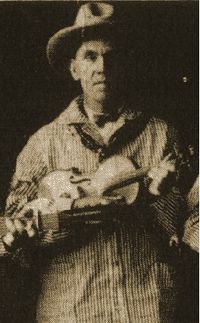Annotation:Merry Widow Waltz: Difference between revisions
No edit summary |
m (Text replacement - "garamond, serif" to "sans-serif") |
||
| (One intermediate revision by one other user not shown) | |||
| Line 1: | Line 1: | ||
=='''Back to [[{{BASEPAGENAME}}]]'''== | =='''Back to [[{{BASEPAGENAME}}]]'''== | ||
---- | ---- | ||
<p><font face=" | <p><font face="sans-serif" size="4"> | ||
'''MERRY WIDOW WALTZ (Die lustige Witwe).''' German (originally), American; Waltz. This was one of the sides on the first, and only, solo fiddle recording made by North Georgia fiddler Ahaz Agustus "A.A." Gray (1881-1939) [http://www.oldtimemusic.com/FHOFAAGray.html], made in Atlanta in March, 1924 (backed with "[[Bonaparte's Retreat (1)]]"). | '''MERRY WIDOW WALTZ (Die lustige Witwe).''' German (originally), American; Waltz. This was one of the sides on the first, and only, solo fiddle recording made by North Georgia fiddler Ahaz Agustus "A.A." Gray (1881-1939) [http://www.oldtimemusic.com/FHOFAAGray.html], made in Atlanta in March, 1924 (backed with "[[Bonaparte's Retreat (1)]]"). | ||
[[File:A.A. Gray.jpg|200px|thumb|left|A.A. Gray]] | [[File:A.A. Gray.jpg|200px|thumb|left|A.A. Gray]] | ||
The melody was composed around 1905 by Austro–Hungarian composer Franz Lehár (1870-1948) for his operetta '''The Merry Widow''', which achieved instant success upon its debut in Vienna, and continues to be popular today. | The melody was composed around 1905 by Austro–Hungarian composer Franz Lehár [http://en.wikipedia.org/wiki/Franz_Leh%C3%A1r] (1870-1948) for his operetta '''The Merry Widow''', which achieved instant success upon its debut in Vienna, and continues to be popular today. | ||
<br> | <br> | ||
<br> | <br> | ||
</font></p> | </font></p> | ||
<p><font face=" | <p><font face="sans-serif" size="4"> | ||
''Source for notated version'': | ''Source for notated version'': | ||
<br> | <br> | ||
<br> | <br> | ||
</font></p> | </font></p> | ||
<p><font face=" | <p><font face="sans-serif" size="4"> | ||
''Printed sources'': | ''Printed sources'': | ||
<br> | <br> | ||
<br> | <br> | ||
</font></p> | </font></p> | ||
<p><font face=" | <p><font face="sans-serif" size="4"> | ||
''Recorded sources'': <font color=teal>OKeh 40110 (78 RPM), A.A. Gray (north Ga., his only solo fiddle record, backed with "Bonaparte's Retreat"), 1924.</font> | ''Recorded sources'': <font color=teal>OKeh 40110 (78 RPM), A.A. Gray (north Ga., his only solo fiddle record, backed with "Bonaparte's Retreat"), 1924.</font> | ||
</font></p> | </font></p> | ||
Latest revision as of 14:21, 6 May 2019
Back to Merry Widow Waltz
MERRY WIDOW WALTZ (Die lustige Witwe). German (originally), American; Waltz. This was one of the sides on the first, and only, solo fiddle recording made by North Georgia fiddler Ahaz Agustus "A.A." Gray (1881-1939) [1], made in Atlanta in March, 1924 (backed with "Bonaparte's Retreat (1)").

The melody was composed around 1905 by Austro–Hungarian composer Franz Lehár [2] (1870-1948) for his operetta The Merry Widow, which achieved instant success upon its debut in Vienna, and continues to be popular today.
Source for notated version:
Printed sources:
Recorded sources: OKeh 40110 (78 RPM), A.A. Gray (north Ga., his only solo fiddle record, backed with "Bonaparte's Retreat"), 1924.
